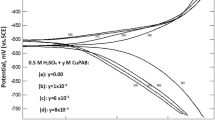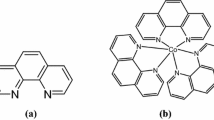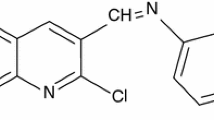Abstract
The divalent copper, cobalt, nickel and cadmium in addition to the trivalent iron complexes of the ligand named (E)-1-((4,6-dimethylpyrimidin-2-ylimino)methyl)naphthalen-2-ol were synthesized by the reaction of the ligand with different metal chlorides. The Structures and geometry of the metal chelates have been successfully deduced applying various analytical and spectroscopic tools such as elemental analysis, molar conductance, TGA, magnetic moment measurements, IR, 1H-NMR, EI-mass and UV–Vis spectral studies. The X-ray single crystal structure of the ligand has been also discussed. Spectral studies and analytical results supported the monobasic bidentate behavior of the ligand connecting the metal ion centers via deprotonated phenolic OH and imine nitrogen. In the case of Cu(II) complex, the pyrimidine nitrogen took part in coordination to the Cu center. The results ensured the monometallic character of the chelates having 1:2 (M:L) ratio for copper, cobalt and nickel and 1:1 (M:L) ration for iron and cadmium complexes. The molar conductance data ensured that all the metal complexes are non-electrolytic type of complexes. All the complexes have been proved to have octahedral geometry. The antimicrobial activities of the synthesized metal chelates were evaluated against different bacterial and fungal strains. The synthesized ligand and its complexes were also examined as inhibitors for the corrosion of mild steel in 1.0 M H2SO4 at 25 °C using various techniques. The experimental outcomes indicated that the inhibition efficiencies of the tested compounds increased as their concentrations increase. The obtained inhibition efficiencies were interpreted on the basis of strong adsorption of the inhibitor molecules on the surface of mild steel and composing good protection films. The adsorption was found to obey Langmuir adsorption isotherm. The results achieved from all applied techniques are obviously compatible.












Similar content being viewed by others
References
P.S. Theivendren, C.R. James, P.V. Dniandev, S.K. Valzita, A mini review of pyrimidine and fused pyrimidine marketed drugs. Res. Pharm. 2, 1–9 (2012)
V. Sharma, N. Chitranshi, A.K. Agarwa, Significance and biological importance of pyrimidine in the microbial world. Inter. J. Med. Chem. 2014, 1–31 (2014)
M. Sonmez, M. Celebi, I. Berber, Synthesis, spectroscopic and biological studies on the new symmetric Schiff base derived from 2,6-diformyl-4-methylphenol with N-aminopyrimidine. Eur. J. Med. Chem. 45, 1935–1940 (2010)
J.I. Pyo, E.J. Hwang, C.S. Cheong, S.H. Lee, S.W. Lee, I.T. Kim, S.H. Lee, Synthesis and photoluminescent properties of novel furopyrimidine derivatives. Synth. Met. 155, 461–463 (2005)
M. Sonmez, M.E. Hacıyusufoglu, A. Levent, H. Zengin, G. Zengin, Synthesis of pyrimidine Schiff base transition metal complexes: characterization, spectral and electrochemical analyses, and photoluminescence properties. Res. Chem. Intermed. 44, 5531–5546 (2018)
A. Elsherbiny, H. El-Ghamry, Synthesis, characterization, and catalytic activity of new Cu(II) complexes of Schiff base: effective catalysts for decolorization of acid red 37 dye solution. Int J. Chewm. Kinet. 47, 162–173 (2015)
K.C. Gupta, A.K. Sutar, Catalytic activities of Schiff base transition metal complexes. Coord. Chem. Rev. 252, 1420–1450 (2008)
A. Prakash, D. Adhikari, Application of Schiff bases and their metal complexes—a review. Int. J. Chem. Technol. Res. 3, 1891–1896 (2011)
S. Kumar, D.N. Dhar, P.N. Saxena, Applications of metal complexes of Schiff bases-a review. J. Sci. Ind. Res. 68, 181–187 (2009)
S. Arulmurugan, H.P. Kavitha, B.R. Venkatraman, Biological activities of Schiff base and its complexes: a review. Rasayan J. Chem. 3, 385–410 (2010)
S. Rostamnia, A. Morsali, Basic isoreticular nanoporous metal–organic framework for Biginelli and Hantzsch coupling: IRMOF-3 as a green and recoverable heterogeneous catalyst in solvent-free conditions. RSC Adv. 4, 10514–10518 (2014)
M. Gaber, N.A. El-Wakiel, H.A. El-Ghamry, S.K. Fathalla, Synthesis, spectroscopic characterization, DNA interaction and biological activities of Mn(II), Co(II), Ni(II) and Cu(II) complexes with [(1H-1,2,4-triazole-3-ylimino)methyl]naphthalene-2-ol. J. Mol. Str. 1076, 251–261 (2014)
M. Gaber, H.A. El-Ghamry, F. Atlam, S.K. Fathalla, Synthesis, spectral and theoretical studies of Ni(II), Pd(II) and Pt(II) complexes of 5-mercapto-1,2,4-triazole-3-imine-2′-hydroxynaphyhaline. Spectrochim. Acta A 137, 919–929 (2015)
M. Gaber, H.A. El-Ghamry, S.K. Fathalla, Ni(II), Pd(II) and Pt(II) complexes of (1H-1,2,4-triazole-3-ylimino)methyl]naphthalene-2-ol. Structural, spectroscopic, biological, cytotoxicity, antioxidant and DNA binding. Spectrochim. Acta A 139, 396–404 (2015)
R. Drozdzak, B. Allaert, N. Ledoux, I. Dragutan, V. Dragutan, F. Verpoort, Coord. Chem. Rev. 249, 3055–3074 (2005)
S. Rostamnia, H. Alamgholiloo, X. Liu, Pd-grafted open metal site copper-benzene-1,4-dicarboxylate metal organic frameworks (Cu-BDC MOF’s) as promising interfacial catalysts for sustainable suzuki coupling. J. Colloid Interf. Sci 469, 310–317 (2016)
H. Alamgholiloo, S. Rostamnia, A. Hassankhani, J. Khalafy, M.M. Baradarani, G. Mahmoudi, X. Liu, Stepwise post-modification immobilization of palladium Schiff-base complex on to the OMS-Cu (BDC) metal–organic framework for Mizoroki-Heck cross-coupling reaction. App. Organomet. Chem. 32, e4539 (2018)
S. Samadhiya, A. Halve, Synthetic utility of Schiff bases as potential herbicidal agents. Orient. J. Chem. 17, 87–94 (2001)
K.Y. El-Baradie, N.A. El-Wakiel, H.A. El-Ghamry, Synthesis, characterization and corrosion inhibition in acid medium of l-histidine Schiff base complexes. Appl. Organometal. Chem. 29, 117–125 (2015)
M. Behpour, S.M. Ghoreishi, N. Mohammadi, M.S. Niasari, Damage analysis and cracking model of reinforced concrete structures with rebar corrosion. Corros. Sci. 53, 3380–3397 (2011)
C. Kustu, K.C. Emregul, O. Atakol, Schiff bases of increasing complexity as mild steel corrosion inhibitors in 2 M HCl. Corros. Sci. 49, 2800–2814 (2007)
M. Behpour, S.M. Ghoreishi, N. Soltani, M.S. Niasari, The inhibitive effect of some bis-N, S-bidentate Schiff bases on corrosion behaviour of 304 stainless steel in hydrochloric acid solution. Corros. Sci. 51, 1073–1082 (2009)
A. Fawzy, I.A. Zaafarany, H.M. Ali, M. Abdallah, New synthesized amino acids-based surfactants as efficient inhibitors for corrosion of mild Steel in hydrochloric acid medium: kinetics and thermodynamic approach. Int. J. Electrochem. Sci. 13, 4575–4600 (2018)
A. Fawzy, M. Abdallah, I.A. Zaafarany, S.A. Ahmed, I.I. Althagafi, Thermodynamic, kinetic and mechanistic approach to the corrosion inhibition of carbon steel by new synthesized amino acids-based surfactants as green inhibitors in neutral and alkaline aqueous media. J. Mol. Liq. 265, 276–291 (2018)
M. Abdallah, O.A. Hazazi, A. Fawzy, S. El-Shafei, A.S. Fouda, Influence of N-thiazolyl-2-cyanoacetamide derivatives on the corrosion of aluminum in 0.01 M sodium hydroxide. Prot. Met. Phys. Chem. Surf. 50, 659–666 (2014)
M.I. Awad, A.F. Saad, M.R. Shaaban, B.A.A.L. Jahdaly, O.A. Hazazi, New insight into the mechanism of the inhibition of corrosion of mild steel by some amino acids. Int. J. Electrochem. Sci. 12, 1657–1669 (2017)
O.A. Hazazi, A. Fawzy, M.R. Shaaban, M.I. Awad, Enhanced 4-amino-5-methyl-4H-1,2,4-triazole-3-thiol inhibition of corrosion of mild steel in 0.5 M H2SO4 by Cu(II). Int. J. Electrochem. Sci. 9, 1378–1389 (2014)
M. Abdallah, A.S. Fouda, I. Zaafarany, A. Fawzy, Y. Abdallah, Corrosion inhibition of iron in sulphuric acid solution by antibacterial cephalosporin. J. Am. Sci. 9, 209–215 (2013)
F. Bentiss, M. Lagrenée, M. Traisnel, J.C. Hornez, The corrosion inhibition of mild steel in acidic media by a new triazole derivative. Corros. Sci. 41, 789–803 (1999)
O.A. Hazazi, A. Fawzy, M.I. Awad, Synergistic effect of halides on the corrosion inhibition of mild steel in H2SO4 by a triazole derivative: kinetics and thermodynamic studies. Int. J. Electrochem. Sci. 9, 4086–4103 (2014)
F. Bentiss, M. Lagrenée, M. Traisnel, 2,5-bis(n-pyridyl)-1 3,4-oxadiazoles as corrosion inhibitors for mild steel in acidic media. J. Corros. 56, 733–742 (2000)
M. Abdallah, M.M. Salem, A. Fawzy, E.M. Mabrouk, Electrochemical behavior of nickel alloys and stainless steel in HNO3 using cyclic voltammetry technique. J. Mater. Env. Sci. 8, 1320–1327 (2017)
R.F. Godec, M.G. Pavlovic, Synergistic effect between non-ionic surfactant and halide ions in the forms of inorganic or organic salts for the corrosion inhibition of stainless-steel X4Cr13 in sulphuric acid. Corros. Sci. 58, 192–201 (2012)
M. Abdallah, I. Zaafarany, A. Fawzy, M.A. Radwan, E. Abdfattah, Inhibition of aluminum corrosion in hydrochloric acid by cellulose and chitosan. J. Am. Sci. 9, 580–586 (2013)
O.A. Hazazi, A. Fawzy, M.I. Awad, Sulfachloropyridazine as an eco-friendly inhibitor for corrosion of mild steel in H2SO4 solution. Chem. Sci. Rev. Lett. 4, 67–79 (2015)
A.A. Osowole, R. Kempe, R. Schobert, K. Effenberger, Synthesis, spectroscopic, thermal, and in vitro anticancer properties of some M(II) complexes of 3-(-1-(4,6-dimethyl-2-pyrimidinylimino)methyl-2-naphthol. Synth. React. Inorg. Met. Org. Nano-Met. Chem. 41, 825–833 (2011)
N.H. Yarkandi, H.A. El-Ghamry, M. Gaber, Synthesis, spectroscopic and DNA binding ability of CoII, NiII, CuII and ZnII complexes of Schiff base ligand (E)-1-(((1H-benzo[d]imidazol-2-yl) methylimino)methyl)naphthalen-2-ol. X-ray crystal structure determination of cobalt(II) complex. Mater. Sci. Eng. C 75, 1059–1067 (2017)
A. Bauer, W. Kirby, C. Sherris, M. Turck, Antibiotic susceptibility testing by a standardized single disk method. Am. J. Clin. Pathol. 45, 493–496 (1966)
M. Pfaller, L. Burmeister, M.A. Bartlett, M.G. Rinaldi, J. Clin. Microbiol. 26, 1437–1441 (1988)
F.H. Allen, O. Kennard, D.G. Watson, L. Brammer, A.G. Open, R. Taylor, Tables of bond lengths determined by X-ray and neutron diffraction. Part 1. Bond lengths in organic compounds. J. Chem. Soc. Perkin Trans. 12, S1–19 (1987)
R. Pradhan, M. Banik, D.B. Cordes, A.M.Z. Slawin, N.C. Saha, Synthesis, characterization, X-ray crystallography and DNA binding activities of Co(III) and Cu(II) complexes with a pyrimidine-based Schiff. Inorg. Chim. Acta 442, 70–80 (2016)
L.B. Tang, G.N. Mu, G.H. Liu, The effect of neutral red on the corrosion inhibition of cold rolled steel in 1.0 M hydrochloric acid. Corros. Sci. 45, 2251–2262 (2003)
A. Majumder, G.M. Rosair, A. Mallick, N. Chattopadhyay, S. Mitra, Synthesis, structures and fluorescence of nickel, zinc and cadmium complexes with the N, N, O-tridentate Schiff base N-2-pyridylmethylidene-2-hydroxy-phenylamine. Polyhedron 25, 1753–1762 (2006)
K. Singh, M.S. Barwa, P. Tyagi, Synthesis, characterization and biological studies of Co(II), Ni(II), Cu(II) and Zn(II) complexes with bidentate Schiff bases derived by heterocyclic ketone. Eur. J. Med. Chem. 41, 147–153 (2006)
H.A. El-Ghamry, S.K. Fathalla, M. Gaber, Synthesis, structural characterization and molecular modelling of bidentateazo dye metal complexes: DNA interaction to antimicrobial and anticancer activities. Appl. Organometal. Chem. 32, e4136 (2017)
R. Holman, M.P. Hendrich, L. Que Jr., EPR studies of a dinickel complex in its (II, II) and (II, III) oxidation states. Inorg. Chem. 31, 937–939 (1992)
R. Paulpandiyan, N. Raman, DNA binding propensity and nuclease efficacy of biosensitive Schiff base complexes containing pyrazolone moiety: synthesis and characterization. J. Mol. Str. 1125, 374–382 (2016)
H. Liu, H. Wang, F. Gao, D. Niu, Z. Lu, Self-assembly of copper(II) complexes with substituted aroylhydrazones and monodentate N-heterocycles: synthesis, structure and properties. J. Coord. Chem. 60, 2671–2678 (2007)
A.M. Gouda, H.A. El-Ghamry, T.M. Bawazeer, T.A. Farghaly, A.N. Abdalla, A. Aslam, Antitumor activity of pyrrolizines and their Cu(II) complexes: design, synthesis and cytotoxic screening with potential apoptosis-inducing activity. Eur. J. Med. Chem. 145, 350–359 (2018)
A.B.P. Lever, Inorganic Electronic Spectroscopy, 2nd edn. (Elsevier, Amsterdam, 1984)
K. El-Baradie, R. El-Sharkawy, H. El-Ghamry, K. Sakai, Synthesis and characterization of Cu(II), Co(II) and Ni(II) complexes of a number of sulfadrugazodyes and their application for wastewater treatment. Spectrochim. Acta A 121, 180–187 (2014)
E.V. Zahınos, M.A.M. Rogado, F.L. Giles, F.J.B. Garcıa, Coordination behaviour of Schiff base 2-acetyl-2-thiazoline hydrazone (ATH) towards cobalt(II), nickel(II) and copper(II). Polyhedron 27, 879–886 (2008)
Y.K. Abdel-Monem, S.A. Abouel-Enein, S.M. El-Seady, Synthesis, characterization and molecular modeling of some transition metal complexes of Schiff base derived from 5-aminouracil and 2-benzoyl pyridine. J. Mol. Struct. 1152, 115–127 (2018)
D.N. Kumar, B.S. Garg, Synthesis and spectroscopic studies of complexes of zinc(II) with N2O2 donor groups. Spectrochim. Acta A 64, 141–147 (2006)
R.S. Joseyphus, M.S. Nair, Antibacterial and antifungal studies on some Schiff base complexes of zinc(II). Microbiology 36, 93–98 (2008)
G.N. Mu, X.H. Li, Q. Qu, J. Zhou, Molybdate and tungstate as corrosion inhibitors for cold rolling steel in hydrochloric acid solution. Corros. Sci. 48, 445–459 (2006)
C. Hsu, F. Mansfeld, Technical note concerning the conversion of the constant phase element parameter Y0 into a capacitance. Corrosion 57, 747–748 (2001)
M. Christov, A. Popova, Adsorption characteristics of corrosion inhibitors from corrosion rate measurements. Corros. Sci. 46, 1613–1620 (2004)
Author information
Authors and Affiliations
Corresponding author
Additional information
Publisher's Note
Springer Nature remains neutral with regard to jurisdictional claims in published maps and institutional affiliations.
Electronic supplementary material
Below is the link to the electronic supplementary material.
Rights and permissions
About this article
Cite this article
Takroni, K.M., El-Ghamry, H.A. & Fawzy, A. Evaluation of the Catalytic Activities of Some Synthesized Divalent and Trivalent Metal Complexes and Their Inhibition Efficiencies for the Corrosion of Mild Steel in Sulfuric Acid Medium. J Inorg Organomet Polym 29, 1927–1940 (2019). https://doi.org/10.1007/s10904-019-01153-9
Received:
Accepted:
Published:
Issue Date:
DOI: https://doi.org/10.1007/s10904-019-01153-9




